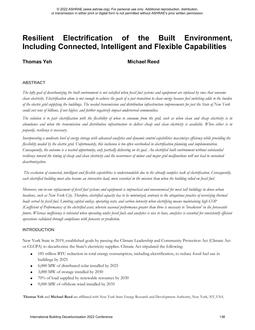Click here to purchase
The lofty goal of decarbonizing the built environment is not satisfied when fossil fuel systems and equipment are replaced by ones that consume clean electricity. Electrification alone is not enough to achieve the goals of a just transition to clean energy because fuel switching adds to the burden of the electric grid supplying the buildings. The needed transmission and distribution infrastructure improvements for just the State of New York could cost tens of billions, if not higher, and further negatively impact underserved communities. The solution is to pair electrification with the flexibility of when to consume from the grid, such as when clean and cheap electricity is in abundance and when the transmission and distribution infrastructure to deliver cheap and clean electricity is available. When either is in jeopardy, resiliency is necessary. Incorporating a moderate level of energy storage with advanced analytics and dynamic control capabilities maximizes efficiency while providing the flexibility needed by the electric grid. Unfortunately, this inclusion is too often overlooked in electrification planning and implementation. Consequently, the outcome is a wasted opportunity, only partially delivering on its goal. An electrified built environment without substantial resiliency toward the timing of cheap and clean electricity and the occurrences of minor and major grid malfunctions will not lead to sustained decarbonization. The exclusion of connected, intelligent and flexible capabilities is understandable due to the already complex task of electrification. Consequently, each electrified building must also become an interactive load, more essential in the mission than when the building relied on fossil fuel. Moreover, one-to-one replacement of fossil fuel systems and equipment is impractical and uneconomical for most tall buildings in dense urban locations, such as New York City. Therefore, electrified capacity has to be minimized, contrary to the ubiquitous practice of oversizing thermal loads served by fossil fuel. Limiting capital outlay, operating costs, and carbon intensity when electrifying means maintaining high COP (Coefficient of Performance) of the electrified asset, wherein seasonal performance greater than three is necessary to ‘breakeven’ in the foreseeable future. Whereas inefficiency is tolerated when operating under fossil fuels and analytics is nice to have, analytics is essential for consistently efficient operations validated through compliance with forecasts or prediction.
Product Details
- Published:
- 2022
- Number of Pages:
- 10
- Units of Measure:
- Dual
- File Size:
- 1 file , 1.7 MB
- Product Code(s):
- D-94056-C18
- Note:
- This product is unavailable in Russia, Belarus
